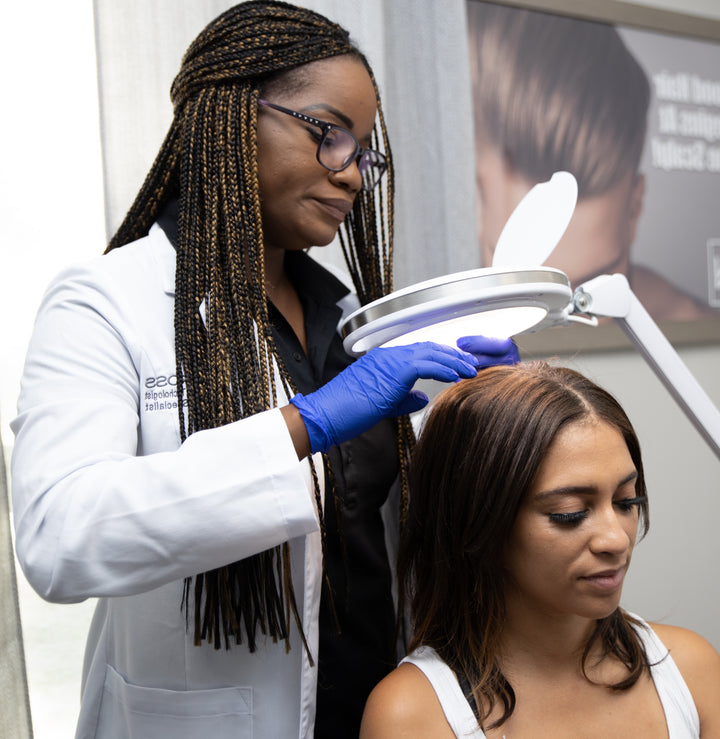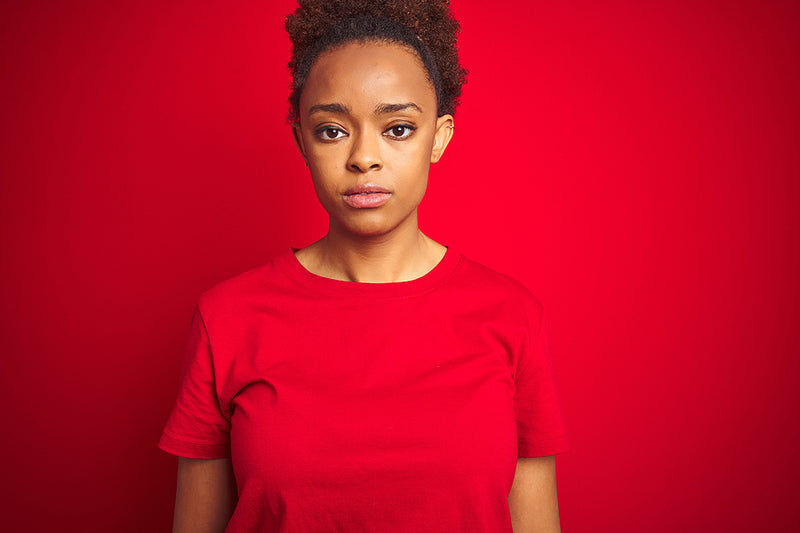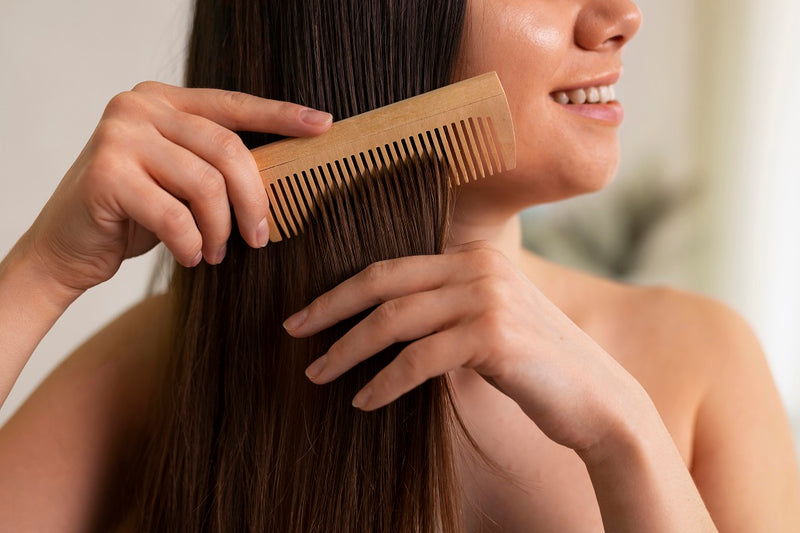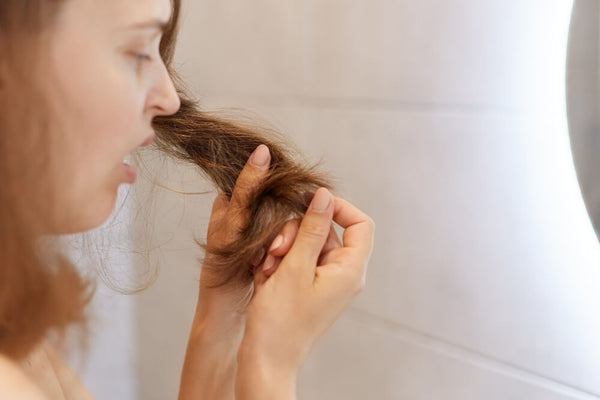Hair therapy is a common practice used by many people worldwide. Hair is integral to our physical appearance, so treating it to improve hair health is exciting and quite appealing to most people.
For some, hair therapy may be necessary; for others, it may be just something they do for themselves or as part of their lifestyle. Regardless of your reasons for trying out this method, one thing is sure, when it comes to treating your hair and scalp conditions, you should always go holistic hair therapy.
What is Hair Therapy?
Hair therapy is a type of alternative medicine based on the idea that treating your hair can treat various health conditions, such as depression and stress.

Hair therapy is a completely non-invasive treatment that can help you achieve healthy and beautiful hair. Hair therapy uses thermal energy to revitalize your scalp, stimulate new hair growth, and promote your scalp's overall health.
Hair therapists claim that if you have healthy hair, then your body will be healthier too. They believe that this is because the protein in our hair acts like an internal barometer of what's going on inside us.
The more stressed you are, or if you feel depressed, it is believed that your body will consequently have less elasticity. This is why hair therapists focus on restoring elasticity in the protein inside your hair as well as other kinds of cells inside your body.
What are the Causes of Hair Loss?
Hair loss could really dent an individual's confidence levels, and the fact is it seems to happen to everyone at some point or other.
Whether you are noticing more hair fall strands than normal clogging up your shower drain, or you suffer from a female pattern baldness, hair loss could be a severe concern, and finding a solution that can work for you is crucial.
According to research in the Journals of Gerontology, black men have been shown to have significantly higher rates of male pattern baldness than white men do. However, hair loss is no longer a problem only faced by men.
Women are also susceptible to this disease, and it may be more common in them than we thought. There are numerous causes of hair loss, and they can result from many factors, such as genetics, stress, and medication use.
The most important thing is to find out why your hair is falling out so that you can take action before it gets worse. Here's what you need to know about the causes of hair loss:

1. Anxiety and stress
High anxiety levels affect not only your mind and body but also your hairline. Generally, this hair loss is temporary in nature, and when you relieve your stress levels, your hair follicles usually return to their natural thickness and length.
Stress and anxiety can cause hormonal imbalances, which is why they can affect hair growth. Stress and anxiety are often caused by genetics, medication, or other things like diet or sleep patterns.
You must embrace holistic living to help combat stress.
2. Hormonal imbalance
Hormonal imbalances are quite common, and they are often caused by many different things.
3. Hair styling products
Long-term use of hair dyes, perms, and hair styling products can lead to baldness. Using harsh chemicals on your hair causes damage and makes it more susceptible to breakage in the future.
Excessive use of heating tools is also among the significant reasons. The more a person uses heat on their hair, the more likely they are to lose it.

4. Wearing your hair too tightly
Even though traction alopecia generally clears up when you stop wearing your tight hairstyle, however, hair loss may persist if your scalp gets damaged and scarring occurs.
5. Hereditary factors
Androgenetic alopecia is a genetic kind of hair loss that gets passed through your genes. It typically impacts more males than females, but females could also be affected. Specific symptoms of androgenic alopecia are bald spots in males and a receding hairline.
6. Endocrine system
The endocrine system affects how fast or slow our bodies produce hormones which play an essential role in regulating growth patterns throughout life—including puberty, menopausal and postmenopausal. If anything disrupts it, it is most likely to affect the hair growth process.
How does Hair therapy work?
Hair follicles are connected to the mind and brain. When you are stressed out, your hair grows slower than usual. Hair fall is a natural process, and losing 50-100 strands of hair a day is completely normal.
However, you lose much more hair than usual when the hair growth process slows down or stops entirely. Hair therapy is a natural way to improve your hair, and it doesn't require any chemicals or lotions!
Hair therapy can be helpful for some people. It's essential to find a board certified trichologist who has experience with hair therapy and knows how to treat your specific condition.
- Hair therapy is a natural way to improve your hair. It doesn't require any chemicals or lotions, and it's an excellent way to improve the condition of your scalp. Your hair will be less prone to breakage and shedding, as well as frizziness.
- Hair therapy can help you grow healthier, stronger hair. You will grow hair that will last longer and resist breakage and shedding. It will strengthen existing roots by stimulating new growth at the root level.
- Hair therapy is a great way to improve the condition of your scalp. This will further strengthen hair follicles. An untreated and unconditioned scalp leads to damage to the roots of your hair and that results in dryness or frizziness in some areas.
- Hair therapy can make your color last longer. Although the results vary from client to client, hair therapy can show visible results when it comes to hair texture and color. While hair therapy can make your color last longer, it can also help your color become more vibrant and even.
PRP Hair Treatment for Hair Loss
What is PRP Hair Treatment?
PRP treatment is a natural way to treat hair loss. This procedure involves the use of blood plasma, which contains growth factors and other nutrients that can be used to stimulate the regrowth of thinning or damaged hair.
PRP treatments are non-invasive and do not require any surgery or chemicals, so they're great for people who are nervous about going under the knife or have sensitive skin. Also, this means you can expect faster results.
How Effective is PRP Hair Treatment for Hair Growth?
PRP is derived from blood that contains many of the growth factors, such as insulin-like growth factor 1 (IGF-1), that promote hair growth.
The stem cells of PRP are separated from your own blood, then multiplied in a laboratory setting and injected into your scalp to encourage new hair growth.
The process works by stimulating existing follicles with IGF-1 growth factor, which causes them to grow longer and more robustly than they would generally be able to do on their own.
This allows you to achieve thicker strands faster with less damage than if you were going through regular treatments.
PRP hair treatments are performed entirely in sync with your body to yield natural results. The treatment has no harsh side effects, and there are no known health risks posed. With hair therapy, it is believed that your body will regenerate itself.
What is the Process of a PRP Treatment?
During each PRP treatment, your consultant draws a tiny amount of blood from your arm. Subsequently, they separate the growth factors already present in your blood specimen by rotating your blood inside a centrifuge.
Overall, this process would take around 10 minutes. Your consultant then sanitizes your entire scalp to prepare to inject the isolated growth factors into it. To ease discomfort, generally, there are medicines available. Then you get a proprietary hair growth formula prescribed that is curated particularly for you.
Ultimately, your consultant employs a carboxy instrument on your scalp. This formula enables to boost blood flow to your scalp and maximizes your hair growth. Soon, the natural healing process in your body starts restoring your hair follicles.
Red light therapy for hair loss
Hair loss is something that affects many people. There are many different causes of hair loss, but one of the most common ones is alopecia areata, which causes bald patches on the scalp or vertex (top) of the head. The treatment session lasts five minutes and is usually administered two to four times a week for weeks or months.

Red light therapy uses red laser light to stimulate hair growth in these types of alopecia areata patients who have tried other therapies without success.
The process of stimulating the hair follicle involves shining a laser beam onto your scalp. This will encourage your body to produce more blood flow and oxygen-rich nutrients that can help promote the growth and regrowth of new healthy follicles.
Red light therapy may also help treat telogen effluvium--a condition where follicles stop shedding their cells for more than four months at a time, causing irregular patches of hair loss.
Red light therapy for hair loss or low-level light therapy is a non-invasive treatment that uses red light to stimulate stem cells. This works as an effective hair fall treatment, and it's safe for people who have sensitive skin or allergies.
It isn't a cure for alopecia areata, but it can be used in conjunction with other treatments like steroids or immunosuppressants.
Benefits of Hair Therapy
Hair doctors recommend hair therapy as a way to improve the quality of the protein cells inside your body. This is done by simply improving the quality of your hair.
However, there are also many other important benefits that come with hair therapy. Here are some of the most significant benefits of undergoing hair therapy:

1. It's Your Own Hair
Hair therapy is entirely different from a hair replacement solution. In fact, it is simply a treatment that encourages your natural hair into growing better than before.
You are merely rejuvenating your hair follicles with this therapy and nurturing natural growth. Since hair therapy simply improves your own hair, it can offer you a tremendous confidence boost and a healthier body image.
Many candidates who have gone through hair therapy feel more confident about their looks due to their improved hair quality shortly after the procedure.
2. Can Delay the Progression of Balding
Hair regrowth therapy can help in jump-starting natural hair growth, as well as delaying the advancement of hair loss. These kinds of treatments help you in holding onto your natural hair for more time than you deem possible.
Even though balding depends on a variety of factors, such as family history, it is possible to delay its onset by strengthening your hair from within.
3. Helps Hair Growing Back Stronger and Thicker Than Ever
Hair regrowth treatments focus on offering your hair follicles and scalp all of the nutrition they need to generate healthy hair. This indicates that after hair therapy, your hair could grow back stronger, thicker, and healthier than ever.
Not only does hair therapy improve the quality of your hair, but it also ensures that you see long-lasting results.

4. Benefits Temporary Hair Loss
For people who are encountering temporary hair loss related to medical treatments or health conditions like chemotherapy, it could get quite anxious waiting for your hair to bounce back.
Temporary hair loss therapy procedures could help your natural hair in growing back faster and even improves its quality.
5. Boost a Healthy Scalp
A healthy scalp is the basis of standard hair growth. All hair regrowth therapies enable a healthy scalp, ensuring that your follicles have all the factors they require for optimized hair growth.
6. They are Safe
One of the best kinds of hair therapy includes topical treatments that are combined with trichology and laser hair therapy.
Laser hair therapy operates low levels of laser light approved by the FDA laser light to improve blood flow to your hair follicles. These can, in turn, facilitate follicles to continue normal hair growth.
Conclusion
When given a choice, a lot of people would want to promote the development of their natural hair. This is precisely what hair therapy aims to do. Hair therapy includes a group of treatments that nurture the hair follicles and scalp to boost natural hair growth.
It can help in repairing scalp damage, reducing hair shedding, and preventing further hair loss, and it is fortified with minerals and vitamins that are needed by your hair and scalp to stimulate healthy hair growth.
Have any more questions? Contact Nina Ross Hair Therapy.
Visit our Appointment Calendar page to book an appointment with a Board Certified Trichologist, Dr. Nina Ross.














